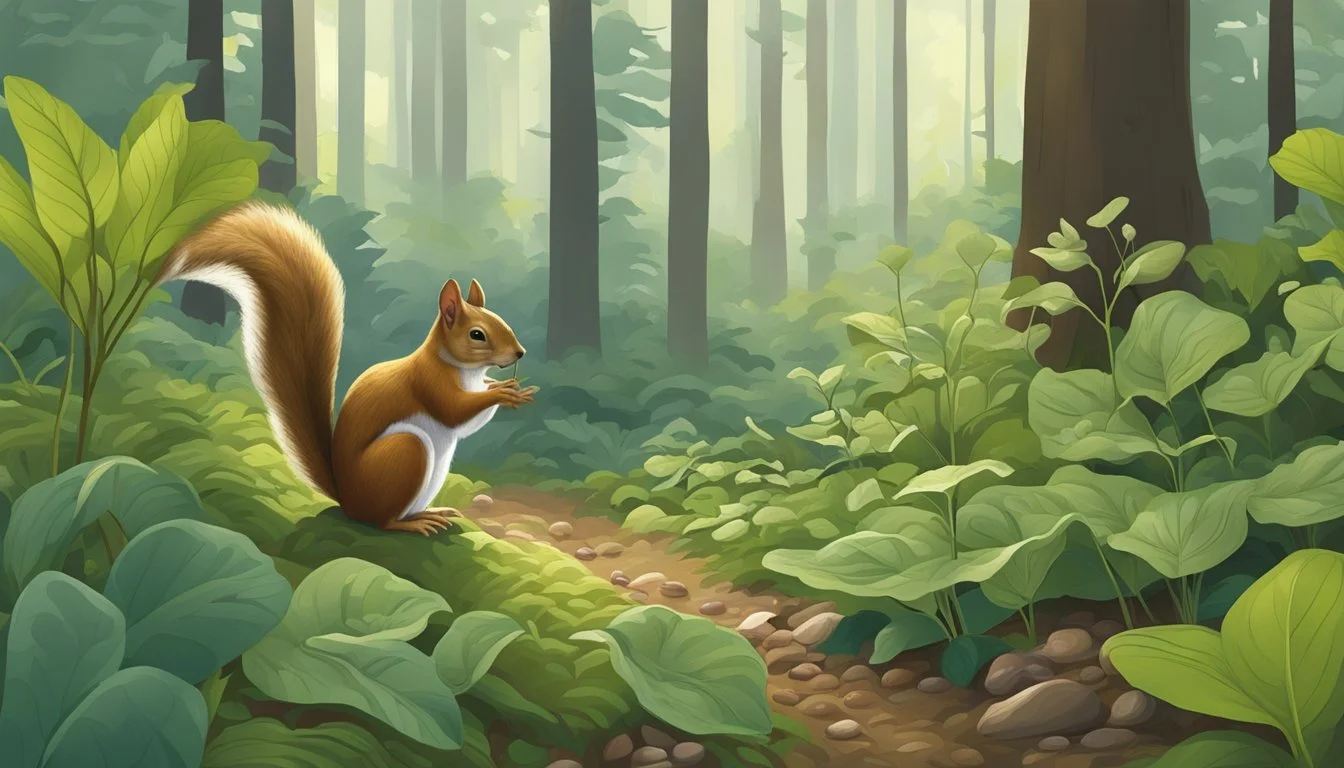Piedmont Native Edible Plants
A Guide to Foraging and Sustainability
Piedmont Native Edible Plants offer an exciting and sustainable way to connect with the local environment of the Piedmont region. With a variety of plant species that have evolved before the influence of European settlements, these plants are well-adapted to the area's specific climate and soil conditions. Foraging for these native plants not only brings a sense of place and history but also provides fresh and nutritious food sources right from your own backyard.
Notable among these native edibles are chickweed, whose leaves, flowers, and stems can be added to salads for a fresh, green taste. Additionally, Apios americana, a climbing vine, produces edible fruits and roots that have been historically used by Native American tribes. This plant serves as both a valuable food source and an attractive, twining vine for garden spaces.
By exploring and utilizing Piedmont native edible plants, individuals can create a more sustainable and eco-friendly lifestyle. Engaging with these native species supports local wildlife, contributes to the preservation of regional biodiversity, and reduces dependence on non-native and potentially invasive species.
Defining Piedmont's Ecosystem
The Piedmont region is characterized by its unique blend of native plants that play a significant role in the local ecosystem. These plants not only enhance biodiversity but also connect the area's historic and cultural heritage.
Significance of Local Flora
Piedmont's native plants have evolved over thousands of years, adapting to the region's specific climatic and soil conditions. These plants provide essential habitats and food sources for local wildlife. Preservation of native flora is crucial for maintaining the biodiversity and resilience of the ecosystems within the Piedmont ecoregion.
Native plants also contribute to the stability of the soil and water systems. Their deep root systems help prevent erosion and manage water runoff, which supports cleaner waterways and more sustainable water resources. Additionally, incorporating these plants into gardens and landscapes reduces the need for extensive maintenance and chemical pesticides.
Historic and Cultural Perspectives
The history of Piedmont's native plants dates back to before European settlement. These plants were integral to the lives of Indigenous peoples, who used them for food, medicine, and cultural practices. This deep connection to the land is an important aspect of the region's heritage.
European colonization introduced new species and agricultural practices that altered the landscape. Despite these changes, many native plants have endured and continue to thrive. They offer a sense of place and continuity, linking modern inhabitants with the land's storied past. The region's native plants serve as living reminders of Piedmont's historic and cultural identity.
Modern conservation efforts strive to protect and revitalize these native species, acknowledging their value not only for ecological health but also for cultural preservation.
Benefits of Native Edible Plants
Planting native edible plants offers numerous advantages for both local wildlife and human communities. These plants support biodiversity, provide sustenance, and contribute to ecological health and social well-being.
For Wildlife
Native edible plants play a crucial role in supporting wildlife. They provide essential food sources and habitats for a variety of animals.
Pollinators such as bees and butterflies rely on the flowers of native plants for nectar and pollen. Deer, songbirds, and other mammals benefit from the fruits, nuts, roots, and leaves of these plants.
For example, native berries and nuts attract and nourish many bird species. Deer forage on the leaves and shoots, helping to manage vegetation naturally. These plants also contribute to the diet of smaller mammals and insects.
Native plants like the American cranberry offer food in moist, boggy environments, creating niches for wildlife that adapted to these conditions. This symbiotic relationship ensures that native edible plants and wildlife thrive together.
For Humans
Native edible plants provide several benefits for human communities. Due to their adaptation to local conditions, they often require less maintenance than non-native species, reducing the need for chemical inputs and extensive care.
These plants offer a sustainable food source. Foragers and gardeners can harvest fruits, nuts, and leaves that are rich in nutrients. Incorporating these into daily diets promotes health and self-sufficiency.
Furthermore, cultivating native edible plants enhances community bonding. Sharing surplus produce or participating in local food swaps fosters a sense of community and mutual support.
Growing native plants also helps reconnect people with their natural surroundings, encouraging a deeper appreciation of local ecosystems and biodiversity. This can foster environmental stewardship and sustainable living practices.
Sustainable Landscaping with Native Species
Sustainable landscaping with native species promotes ecological balance and minimizes the need for external resources. This approach supports local wildlife, reduces maintenance, and ensures a thriving environment for both ornamental and edible plants.
Creating a Native Plant Garden
Creating a native plant garden begins with selecting species that have naturally adapted to the local climate and soil. These plants require less water, fewer fertilizers, and minimal pesticides. It's essential to research and choose native plants that match the specific conditions of the Piedmont region.
A mix of shrubs, perennials, and ground covers can create a layered, aesthetically pleasing garden. Including edible native plants like Vaccinium (blueberries) and Asimina triloba (pawpaw) can integrate functionality with visual appeal. Proper spacing and grouping of plants based on similar moisture and sunlight needs help in maintaining a healthy garden ecosystem.
Local resources such as the North Carolina Native Plant Society and North Carolina Botanical Garden can provide guidance and plant sources. Utilize mulching to conserve soil moisture and prevent weed growth. Implementing rain gardens or xeriscaping techniques can further enhance sustainability by maximizing water efficiency.
Deer Resistant Planting
Incorporating deer-resistant plants is crucial to protect your garden from damage. Deer prefer certain plants over others, and selecting species that are less palatable can minimize their impact on your landscape. Plants with strong scents, tough textures, or toxic properties are generally avoided by deer.
For the Piedmont area, effective deer-resistant options include Rhus aromatica (fragrant sumac), Solidago (goldenrod), and Echinacea purpurea (purple coneflower). Mixing these with ornamental grasses or other perennials like Lavandula (lavender) and Nepeta (catmint) can create a diverse and appealing garden that also remains deer-proof.
Regularly rotating plant types and incorporating physical barriers such as fences or nettings can further enhance protection. Using companion planting strategies—like integrating deer-resistant varieties among more vulnerable plants—can create a natural deterrent. Always consult local experts for the best results tailored to your specific area.
Seasonal Guide to Piedmont Flora
The Piedmont region boasts a rich array of native edible plants that thrive through various seasons. This guide provides details about the region’s seasonal offerings, highlighting key plants that are available from early spring to autumn.
Spring Bounty
With the arrival of early spring, the Piedmont landscape comes alive with edible plants. One of the first to appear is the ramps (Allium tricoccum). These wild leeks are prized for their strong flavor and can be used in salads and soups.
Wild strawberries (Fragaria virginiana) also begin to ripen during this period. These small, sweet berries often grow along woodland edges and clearings.
Spring Beauty (Claytonia virginica) is a common spring ephemeral. Its fleshy roots are edible and can be roasted or boiled.
Summer Harvest
The summer season in Piedmont is marked by a plethora of fruits and berries. Blackberries (Rubus spp.) start ripening in early summer, providing a juicy, sweet treat that can be eaten fresh or used in desserts.
Mayapple (Podophyllum peltatum) fruits become sweeter and more palatable during the summer. Care must be taken to consume only the ripe, yellow fruits as unripe ones are toxic.
Elderberries (Sambucus canadensis), known for their dark purple clusters, are harvested later in the summer. They are commonly used to make jams, syrups, and wines.
Autumn Offerings
Autumn brings a new wave of edible plants in the Piedmont region. Persimmons (Diospyros virginiana) are a standout during this season. These small, orange fruits need to be fully ripe to enjoy their sweet, custard-like pulp.
Pawpaw (Asimina triloba) is another native fruit that ripens in the fall. Resembling a tropical fruit, its creamy flesh has a banana-like flavor and can be eaten fresh or used in baking.
Hickory nuts (Carya spp.) also fall to the ground in autumn. They are nutritious and can be cracked open and eaten raw or roasted for a more intense flavor.
Plant Profiles
The Piedmont region hosts a plethora of native edible plants that thrive in its diverse environments. This section highlights key native trees, shrubs, vines, and ferns and grasses that are both ecologically valuable and beneficial for landscaping.
Trees
Amelanchier arborea (Serviceberry): This small tree produces sweet, edible berries that are popular with both wildlife and humans. Serviceberries can be eaten fresh or used in pies and preserves.
Quercus virginiana (Live Oak): While not typically considered for edible use, its acorns can be leached and processed to make flour. The tree provides dense shade and supports numerous wildlife species.
Fagus grandifolia (American Beech): The nuts of the American Beech are edible, although they are small and labor-intensive to harvest. The tree itself is majestic, with smooth bark and golden fall foliage.
Liriodendron tulipifera (Tulip Poplar): Known more for its timber, the inner bark has traditional uses in herbal medicine. Its large, tulip-shaped flowers provide nectar for bees and hummingbirds.
Shrubs
Vaccinium spp. (Blueberries): These shrubs are prized for their delicious and nutritious berries. Native blueberries are well-adapted to the acidic soils of the Piedmont region.
Rhus glabra (Smooth Sumac): The red berries of smooth sumac can be used to make a tangy, vitamin C-rich beverage. This shrub also provides striking fall color.
Ilex verticillata (Winterberry): Although its berries are not typically consumed by humans, they are a crucial winter food source for birds. Its bright red berries and glossy leaves are aesthetically appealing.
Ceanothus americanus (New Jersey Tea): Historically used as a tea substitute during the American Revolution, the leaves of this shrub can be dried and brewed. It also fixes nitrogen in the soil, improving fertility.
Vines
Vitis rotundifolia (Muscadine Grape): This robust vine produces large, sweet grapes that can be eaten fresh or used in jams, jellies, and wines. It thrives in the warm climate of the Piedmont region.
Passiflora incarnata (Maypop): Also known as passionflower, this vine produces edible fruits that are enjoyed raw or made into jellies. Its flowers are striking and attract pollinators.
Smilax spp. (Greenbrier): Young shoots and tender leaves of greenbrier can be eaten like asparagus. The roots can be ground into a starchy meal.
Campsis radicans (Trumpet Vine): While not edible, it's worth mentioning for its vibrant, trumpet-shaped flowers which attract hummingbirds. It’s easy to grow and can cover large areas.
Ferns and Grasses
Adiantum pedatum (Northern Maidenhair Fern): Though not typically used as food, this delicate fern adds beauty to shaded garden areas. It’s valued for its unique, fan-shaped fronds.
Cinnamon fern (Osmundastrum cinnamomeum): While not commonly eaten, some parts have historical medicinal uses. Its tall, cinnamon-colored fronds are visually striking.
Schizachyrium scoparium (Little Bluestem): This native grass provides excellent habitat and food for wildlife. It's drought-resistant and ideal for low-maintenance landscapes.
Panicum virgatum (Switchgrass): Well-known for its biomass potential, switchgrass also serves as forage for livestock. It stabilizes soil and can adapt to various growing conditions.
Foraging Tips and Ethics
When foraging for native edible plants in the Piedmont region, it is essential to prioritize safety and respect for nature. Following best practices ensures a sustainable and enjoyable foraging experience.
Safe Foraging Practices
Proper Identification: Always correctly identify plants before consumption. Use reliable field guides or apps with clear photos and descriptions. Incorrect identification can lead to poisoning.
Respect Allergies: Be aware of potential allergies to plants. For example, stinging nettles can cause skin irritation, and some individuals may react to certain berries or mushrooms.
Harvesting Techniques: Avoid over-harvesting. Only take what you need and leave enough for plant regeneration and wildlife sustenance. Gently trim parts of the plant without uprooting it.
Avoid Contaminated Areas: Do not forage near roadsides, industrial sites, or areas treated with pesticides. Plants in these areas may absorb harmful chemicals.
Legal and Environmental Considerations
Know the Laws: Familiarize yourself with local, state, and national foraging regulations. Some areas may have restrictions on foraging to protect certain species or habitats. Obtain permits if required.
Private Property: Always seek permission before foraging on private land. Trespassing is illegal and disrespectful.
Protected Species: Be aware of and avoid foraging protected or endangered plants. Collecting these can harm ecosystems and result in legal penalties.
Leave No Trace: Adhere to the principle of leaving no trace. Minimize your impact by not disturbing the surrounding environment and cleaning up after yourself. Avoid littering and ensure that you do not damage the habitat.
These practices help maintain the balance of the ecosystem while allowing the enjoyment of nature's offerings.
Culinary Uses and Nutritional Benefits
Native edible plants in the Piedmont region offer unique culinary opportunities and nutritional advantages. Key plants include pawpaw, serviceberry, and wild onions, each contributing distinct flavors and valuable nutrients.
Traditional Recipes
Pawpaw pudding and custards were common in traditional recipes, leveraging the creamy texture and sweet flavor of the fruit. Serviceberries were often used in preserves, jams, and pies. Their semi-sweet flavor made them a versatile ingredient in mid-19th-century kitchens.
Wild onions, or ramps, were typically used in soups and stews. These plants provided a garlicky taste, enhancing the flavor profiles of hearty dishes. Roots and nuts from other native plants were also incorporated into bread and baking recipes, adding nutritional density.
Modern Culinary Applications
In contemporary culinary practices, pawpaws can be found in a variety of gourmet dishes, such as pawpaw ice creams and smoothies. They are also incorporated into savory sauces to complement proteins like pork and chicken.
Serviceberries are widely used in healthy snacks like granola bars and dried fruit mixes. Additionally, they have found a place in modern desserts including serviceberry sorbet and tarts.
Wild onions remain popular in farm-to-table cuisine, often featured in salads and pickles. Their potent flavor continues to make them a sought-after ingredient in gastronomy. The roots and nuts of various Piedmont plants are now commonly used in vegan and health-centric recipes, providing an abundant source of protein and essential vitamins.
Conservation and Preservation
Effective conservation and preservation strategies are essential for maintaining Piedmont native edible plants. These efforts involve both protecting native species and actively combating invasive species.
Protecting Native Species
Native plants play a crucial role in the local ecosystem by supporting native wildlife and contributing to soil health. They have evolved to thrive in the region's unique climate and soil conditions. Protecting these plants involves identifying key species that contribute to ecological balance and ensuring their habitats are maintained.
Providing education on the importance of native species is essential. Workshops and community engagement activities can raise awareness. Additionally, collaborating with local nurseries to supply native plants ensures availability for restoration projects.
Combating Invasive Species
Invasive species like kudzu can disrupt local ecosystems by outcompeting native plants for resources. Controlling these invasive species involves monitoring and rapid response strategies.
Methods include mechanical removal, applying targeted herbicides, and introducing biological controls to reduce invasive populations. Encouraging natural predators and allies like beneficial bacteria can also help maintain the balance. Community participation in removal efforts can enhance efficiency and foster a sense of environmental stewardship. Implementing strict regulations on the sale and transport of invasive species helps prevent their spread.
Resources and Further Reading
For those interested in Piedmont native edible plants, several databases and local organizations can provide valuable information.
Native Plant Databases
Piedmont Native Plant Database: This database offers comprehensive information on plants native to the Virginia Piedmont region. It includes details on plant species that existed before European settlement. The database is well-organized and user-friendly, making it easy to find specific plants and their attributes.
Digital Atlas of the Virginia Flora: A detailed online resource that presents data on the distribution and characteristics of native plants in Virginia. This atlas is a helpful tool for anyone looking to understand the native flora, including edible varieties.
Georgia Piedmont Edible Plants Guide: A detailed guide discussing the edible plants native to the Georgia Piedmont. It includes practical tips and health benefits associated with these plants. The guide provides clear instructions on identifying and utilizing these species.
PDF Guides and Factsheets: Numerous downloadable PDFs, such as the “Piedmont Native Plant Guide” and other native fruit and nut tree factsheets, offer extensive visual and textual details on edible plants in the region. These guides are designed to assist gardeners and enthusiasts in identifying and growing native edible plants.
Local Organizations
Virginia Native Plant Society (VNPS): VNPS offers a plethora of resources, including educational workshops, field trips, and publications on Virginia’s native plants. Their website provides updated information and events, making it an excellent resource for both novices and experts.
Piedmont Environmental Council: This organization focuses on the conservation and promotion of native plants in Virginia’s Piedmont region. They offer events, publications, and volunteer opportunities aimed at supporting native plant ecosystems.
North Carolina Native Plant Society: A society dedicated to preserving and educating about native plants in North Carolina, including the Piedmont region. They feature plant sales, educational programs, and a rich database of local native species.
Local Extension Services: Various Cooperative Extension services, such as those affiliated with universities in Virginia and Georgia, provide region-specific advice, training, and resources on native plants. They often hold workshops and produce detailed guides to assist in gardening and landscaping with native plants.
These resources can significantly enhance one's knowledge and practical skills in cultivating and utilizing native edible plants in the Piedmont region.











